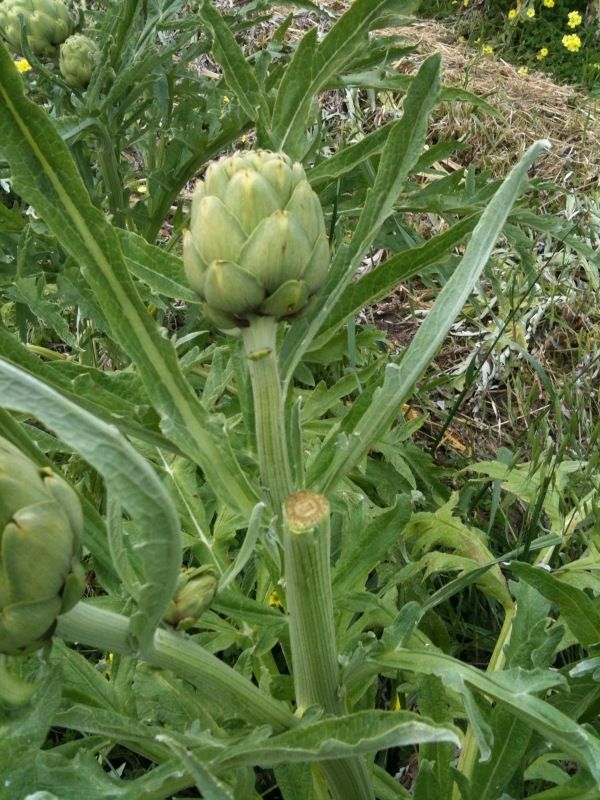A16 and SPQR wine director/owner Shelley Lindgren’s reputation for seeking out Italian wines made with little-known grapes has earned her recognition as a wine pioneer. She has been named Best Wine Director in San Francisco magazine, Best New Sommelier from Wine & Spirits, and a Top Ten Sommeliers by Bloomberg Markets magazine. Yet Lindgren, who has worked in restaurants since high school, feels that her job is less about creating high-profile wine lists and more about sharing her passion for wine and hospitality with guests. Lindgren continues to search for evocative wines to serve at A16 and SPQR. To stay current, she embarks on rigorous tasting trips to Italy twice a year.
Perennially pairing wines with artichokes has been the opposite of a chore; it’s one of my favorite things to match (almost more than anything). I usually order artichokes whenever I see them on a menu, and routinely add them to my basket at the market. Is it weird to think that if I sipped on the Italian artichoke liqueur, Cynar, I am actually helping regenerate my liver tissue? Artichokes are loaded with phytonutrients, and have been found to really be beneficial for healthy living—but the liver is not the only thing they aid, the list is long. In all seriousness, I feel like I am eating a luxury item every time I get to the tangy, sweet, bitter, and meaty heart.
Ultimately, food and wine are both meant to fill a person’s soul and belly, and the goal is to enjoy both. There is a real magic when the winning combination of food and wine can complement each other, and make eating and drinking a memorable experience. Our motto of “if it grows together, it goes together” is always a fun way of selecting either the food or wine first, and then matching it according to regional dictation. This brings us to our local, northern California wines and straight to countries like Greece, Italy, France, and Spain (among others) with fabulous artichoke recipes and a plethora of wines.
The baby artichokes we see in the stores come from the bottom of an artichoke plant; the larger globes are more mature and come from the top of the thistle—and usually this is where the petals can almost be snacks, until revealing the prized heart. The cool thing about baby artichokes is that we eat the entire thing. This is really important for wine pairing, because whole artichokes contain much more bitterness, fiber, and acidity—important factors to consider when selecting wines.
Basically, you cannot go wrong with a dry white wine with artichokes, from sauvignon blanc to greco di tufo. Usually any preparation of artichokes involves using lemon in some way to stop browning, but it’s also a complementary flavor, slowing oxidation as the bursts of acid accentuate the flavors.
Washing down a bite of baby artichoke with a wine with great verve like a pinot bianco from Alto Adige, Italy, has the same effect as squeezing a lemon and a pinch of salt over the baby artichoke and biting into it. Acid loves acid, and also it can cut through the natural bitterness and richness of the artichoke, so crisp whites are ideal in general. There are many reds that can go with the dense, rich centers of globe artichokes, too.
When artichokes were introduced to Italy by the Roman empire, they traveled from North Africa to Sicily and Naples first, then kept moving throughout Italy to the south of France, Spain, and eventually California.
The reds along this Mediterranean basin have generous fruit, which can have a natural bitterness and less-austere tannins that provide a silky texture and help bring out the herbal, meaty richness of an artichoke heart and not isolate the tannins, producing a metallic flavor like some bold, tannic wines can. At A16, chef Liza Shaw is poaching small purple artichokes in olive oil and adding them to a bianca-style pizza with fresh ricotta, smoked mozzarella, house-made prosciutto cotto, roasted red onions, and basil. The winning match for this pizza is a red from Lazio, just outside Rome proper, the Terenzi, ‘Velobra,’ Cesanese del Piglio, Lazio 2006. This medium-full bodied wine, with its natural baking spice quality and red currant flavor, meld perfectly with the rich nature of the pizza. The artichokes and basil become the main flavors—the density of the fruit highlights the vegetables and almost cancels out with the cheese, crust, and prosciutto cotto. It’s a red wine example of complementary flavors for artichokes.
Conversely at SPQR, chef Matthew Accarrino lightly pickles baby artichokes as he braises them in white wine vinegar, carrots, celery, and onions, and they are served warm in the vignarola salad with fresh Cypress Grove goat cheese, country bread, fava leaves, dandelion greens, pea shoots, sugar snap peas, English peas, snow peas, tarragon, mint, parsley, and more. The ideal match for this, after trying many types of pairings, is the Castel de Paolis, Frascati Superiore, Lazio 2007. With approximately twenty-seven ingredients in this salad, the blend of seven indigenous grapes of Lazio—such as romanesca, bonvino, and malvasia del Lazio—pairs with the high acid of goat’s cheese, and the three types of peas, fava leaves, and herbs—both the grapes and greens are mixtures of symbiotic flavors. The sweet, oaky, and firmly tannic wines that did not match, however, brought out astringent, metallic flavors and really clashed.
Speaking foreign languages is not my strong point, but, I can toast in a multitude of them—and they are often based on drinking (and eating) to one’s health. Enjoy the health benefits of eating artichokes, drinking wine, and your future artichoke and vino pairings…à votre santé, saluti, and stin iyiamas!




